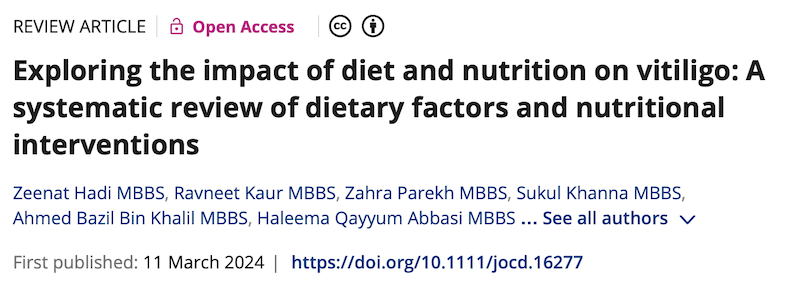New
Impact of Diet and Nutrition on Vitiligo
Recent research underscores the potential of diet and nutrition in managing vitiligo, particularly as some traditional therapies focusing solely on its autoimmune aspects may fall short. Dietary supplements and herbal adjuncts are emerging as promising supportive treatments, playing a significant role in mitigating disease activity.
Systematic Review Insights
A systematic review of 14 studies from 2003 to 2023 explored the link between diet and vitiligo. It revealed that high levels of heavy metals, including Cadmium, Lead, and Mercury, are significantly linked to adverse health outcomes in older adults. Conversely, in younger adults, low levels of Vitamin D and deficiencies in Folic Acid and Vitamin B12 were associated with an increased risk of vitiligo. Additionally, variations in Zinc levels and fatty acids were also connected to vitiligo in this age group.
The Potential of Antioxidants
The review also noted the anti-inflammatory properties of Vitamins C, D, and B12 and their role in reducing reactive oxygen species (ROS), which can aid in managing vitiligo. Combining these vitamins with topical corticosteroids has shown effectiveness, although hyper-doses of Vitamin C may actually worsen the condition. Vitamin D’s role remains controversial; a small and controversial study suggests that high-dose, short-term supplementation can improve repigmentation, though a standard dose of up to 4,000 IU daily is generally beneficial. Polyunsaturated fatty acids (PUFAs) and Alpha Lipoic Acid (ALA) are thought to modulate the immune system beneficially, yet despite their antioxidant properties, they did not significantly improve outcomes.
Genetic Analysis and Antioxidant Therapy
Another groundbreaking study from China evaluated the effects of antioxidant dietary supplements and diet-derived circulating antioxidants on vitiligo using MR analysis. It found that coffee, red wine, and standard tea—all rich in antioxidants—acted as protective factors against vitiligo. These beverages help clear free radicals, enhance plasma reductase activity, and balance the accumulation of ROS.
Coffee, in particular, is a robust source of dietary antioxidants, containing various phytochemicals that scavenge free radicals and modulate the immune response. Red wine, rich in phenols, enhances the serum’s antioxidant capacity and protects against peroxidation-induced damage. Tea, with its high content of polyphenols, offers significant antioxidant activity that varies with its cultivation and processing.
Clinical Guidelines and Future Directions
The European Dermatology Forum Consensus suggests that combining phototherapy with oral antioxidants might enhance treatment outcomes, particularly by counteracting the oxidative stress induced by UV radiation. While promising, these findings, mostly based on a European population, may not be universally applicable.
Conclusion
As interest in complementary medicine grows, dietary interventions are becoming an invaluable part of vitiligo management. These interventions, particularly antioxidants, can serve as effective adjuncts to traditional treatments, offering the potential for fewer side effects. To fully integrate these into treatment protocols, further extensive clinical trials are needed to provide robust evidence and standardize approaches, thereby enhancing the overall management of vitiligo.
UPDATE (October 2, 2024)
SUGGESTED READING
- Is there a special diet for vitiligo?
- Can a gluten-free diet help with vitiligo?
- Is there a traditional medicine to treat vitiligo?
REFERENCES
- Di Nardo V, Barygina V, França K, Tirant M, Valle Y, Lotti T. Functional nutrition as integrated approach in vitiligo management. Dermatol Ther. 2019; 32(4):e12625.
- Hadi Z, Kaur R, Parekh Z, et al. Exploring the impact of diet and nutrition on vitiligo: A systematic review of dietary factors and nutritional interventions. J Cosmet Dermatol. March 11, 2024.
- Ni Y, Zhang Y, Sun J, Zhao L, Wu B, Ye J. The effect of antioxidant dietary supplements and diet-derived circulating antioxidants on vitiligo outcome: evidence from genetic association and comprehensive Mendelian randomization. Front Nutr. 2024 Jan 11.

FAQOther Questions
- What's better: laser or phototherapy?
Laser therapy is actually a type of phototherapy. Both rely on light to trigger changes in the skin, but they work differently. Phototherapy usually means a narrow-band UV (NB-...
- Is there a link between vitiligo and depression?
Depression and anxiety are often linked with vitiligo, significantly impacting a person’s quality of life. The connection stems from the shared origin of the skin and brain duri...
- How Vitiligo Changes with Age?
Vitiligo, a condition characterized by the loss of skin pigmentation, can affect individuals at any stage of life. While it often appears before the age of 20, its progression a...
Though it is not always easy to treat vitiligo, there is much to be gained by clearly understanding the diagnosis, the future implications, treatment options and their outcomes.
Many people deal with vitiligo while remaining in the public eye, maintaining a positive outlook, and having a successful career.
Copyright (C) Bodolóczki JúliaBy taking a little time to fill in the anonymous questionnaire, you can help researchers better understand and fight vitiligo.
